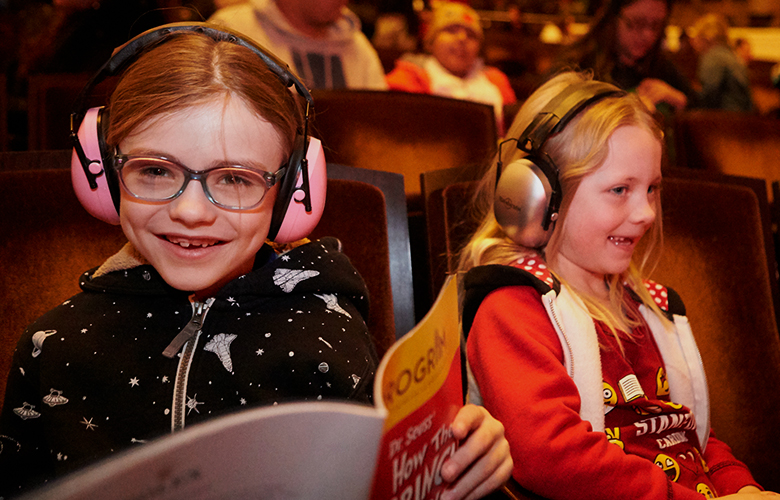
Between April 2018 and March 2020, The Smith Center presented two sensory friendly performances of touring Broadway productions, as well as four sensory friendly performances from national and international touring companies and artists. To find out more about Accessibility at The Smith Center, we spoke with Melanie Jupp, who gave us an insight and introduction to sensory friendly shows and the financial elements involved with putting on a performance.
Melanie Jupp is the Associate Director of Education and Outreach at The Smith Center for the Performing Arts and has served as project lead for The Smith Center’s sensory friendly programming, which is accomplished through the collaborative work of numerous individuals and departments of The Smith Center. Sensory friendly programming is one step presenting venues can take toward prioritising inclusion in their organisations.
Sensory friendly performances are performances that are specifically designed to be inclusive and accommodating for people who may be on the autism spectrum, have an intellectual disability, or any other sensory sensitivities. The intentional design of a sensory friendly performance is reflected in the production as well as in the theatre environment.
For people with these disabilities or sensitivities, a performance that does not include adaptations to support people disabilities or sensory sensitivities might be too overwhelming for them to enjoy the experience.
Sensory friendly performances aim to create more ambient environments so that those with disabilities or sensitives can fully enjoy a performance, with relaxed theatre etiquette to help alleviate the anxiety or feeling of overwhelm these individuals or their families/companions might experience while attending a show.
Sensory friendly shows may also be referred to by some organisations as autism friendly performances or relaxed performances. The choice is specific to the organisation and the overall demographic and philosophy it is seeking to support. Each type of performance has a similar goal of making theatre more accessible for people who may benefit from the accommodations offered.
Sensory friendly performances are created and presented for individuals with autism, intellectual disabilities, or sensory sensitivities. These disabilities and experiences may affect the way a person can enjoy a performance. Sensory processing differences are commonly present in individuals with autism and other intellectual disabilities.
While many are sensitive to sound that is too loud or lighting effects that are too bright or overstimulating, there are also people with sensory processing differences who have a need for louder volume levels and can appreciate bright lighting effects.
Identifying the needs of our local population required the involvement of many community partners representing organisations and clinics that serve people with these disabilities and needs. Their collective guidance and support is an invaluable element of our sensory friendly programming as they educate and advise us on the specific needs of their clients and our fellow community members.
Following The Smith Center’s opening in 2012, we almost immediately heard interest from some community members who wanted us to consider presenting sensory friendly performances. We put it on our wish list as we continued building our programming. In early 2017, the first opportunity to consider presenting a sensory friendly performance of a touring Broadway musical became available.
Up until this point, our education and outreach team had been seeking and participating in numerous opportunities to learn more about sensory friendly performances, so that we would be ready to confidently move forward when the right moment presented itself. Before we committed to offering this show, we assembled a Sensory Friendly Advisory Committee comprised of therapists, nonprofit leaders, medical doctors, and advocates from local organisations serving people with disabilities in our community. We shared information about the opportunity with them and discussed the adjustments that would be required for us to guarantee a successful experience for attendees.
Soon after that meeting, we committed to offering one sensory friendly performance of the touring Broadway production of Disney’s The Lion King for November 2018. Another critical step in our planning process was applying to participate in TDF’s National Autism Friendly Performance Training Program. Once we were accepted, TDF’s Accessibility team offered us additional advice over several conversations, which was another invaluable part of our planning process.
The cost for a presenting organisation to offer a sensory friendly performance can vary greatly depending on the performance and the many logistics related to presenting performances.
Depending on arrangements made between the show’s producers and the presenting organisation, the cost can run anywhere from $50,000 – $150,000.
The rate is typically decided based on a combination of factors, with one important aspect being an organisations’ fundraising capacity and overall philosophy on how to make ticket prices accessible for the intended audience. If an organisation plans to offset ticket prices in order to make pricing more accessible for families, the organisation has more fundraising responsibility.
We also offer sensory friendly performances from touring companies who create theatre for young audiences and are accustomed to staging sensory friendly adaptations. These performances are often held in our studio theatre and are a fraction of the cost of a Broadway touring production.
Many departments and staff members of The Smith Center collaborate to ensure the success of a sensory friendly performance including education and outreach, front of house, marketing, development, theatre operations, and security. Additionally, we identify several “expert” volunteers to help support our staff and guests. These expert volunteers typically come from other nonprofit organisations and medical clinics focused on serving people on the autism spectrum and with intellectual disabilities. These volunteers usually hold certifications such as Registered Behaviour Technician, Board Certified Behaviour Analyst, Occupational Therapist, Speech-Language Pathologist, and sometimes we will have a Neuropsychologist join us as well.
On the day of a sensory friendly performance of a Broadway touring production in our theatre, we hold a pre-show orientation for all staff members, expert volunteers, and other community volunteers to review best practices for supporting our audience that day.
The golden rule is always to follow the lead of a family member, caregiver, or friend who is accompanying a guest with a disability as our number one goal is to make sure they feel welcome and have an enjoyable experience.
Our expert volunteers play a variety of roles during the sensory friendly performance, including supporting Quiet Zone spaces where an audience member may choose to visit if they need to take a break from the performance and being stationed in critical areas inside the theatre to help redirect an enthusiastic audience member who may have aspirations to join the performers on stage!
We greatly appreciate the support we have from our expert volunteers, who are often a friendly face to many of the families and groups in attendance.
From the perspective of an education department, our role in the fundraising process is to collaborate with and support our development colleagues in identifying and providing information for funders who are interested in supporting these types of initiatives.
An organisations’ fundraising capacity will dictate how much they can commit to offering tickets at a more accessible price point. Individuals with disabilities and their family members often face financial hardships due to medical costs and underemployment and carefully pricing tickets is an important aspect of sensory friendly programming.
As an organisation with only a few years of experience in sensory friendly programming, we still have much to learn and many ideas to implement as time and budgets allow. To make the Arts more inclusive for people with disabilities, organisations need to prioritise the thoughtful design of public spaces and events with the intentional inclusion of people with disabilities.
As many organisations are currently examining their values and practices in diversity and inclusion, it is imperative for disability inclusion to be among the top priorities if it is not already part of the fabric of an organisation.
Most arts professionals truly believe the arts are for everyone, but how often do we examine our own practices to make sure we really are ensuring seamless experiences for everyone attending our performances or events?
Learning about disability and understanding best practices for inclusion takes a lot of time and careful attention, but it must be done if we want the arts to continue to be seen as a place where all people belong.
In addition to creating programs for people with disabilities, arts professionals need to spend time learning more about disabled playwrights, dancers, musicians, and actors as well as theatre and dance companies who prioritise disability inclusion in their work. Along with designing our theatres and performance experiences to be inclusive of people with disabilities, we also need to employ people with disabilities and create workforce development programs.
Organisations can also commit to programming performances that represent disability in their themes, storytelling, and inclusion of disabled performers.
The need to be more inclusive of people with disabilities is not exclusive to our field, but the arts are uniquely positioned to address this problem.
Wherever an organisation may choose to start, it is important they take intentional steps to learn from people with disabilities in their community and thoughtfully create a plan for improving and expecting inclusion throughout their organisation.
I think it’s important to share a note regarding language: as a person without a disability, using appropriate language when speaking about disability is critical and requires intentional, ongoing learning. This article utilises person-first language (i.e. “people with disabilities”) but different people will have different preferences for how their disability is acknowledged. When speaking with or referring to a specific person with a disability, it is always best to defer to the language the individual prefers.
I want to be responsible about the information we are providing for an audience that may not have much experience in this area. A helpful resource for those wanting to understand more about language can be viewed here.
Website: https://www.thesmithcenter.com/
Facebook: @thesmithcenter
Twitter: @SmithCenterLV
Instagram: @smithcenterlv
YouTube Channel: here
James “Fitz” FitzSimmons Interview: The Boys In The Band On Netflix
Andrew Lloyd Webber: Arts At The Point Of No Return


Michelle is a musician and composer from the UK. She has performed across the UK and Europe and is passionate about arts education and opportunities for women and girls.
Read Full Profile© 2021 TheatreArtLife. All rights reserved.

Thank you so much for reading, but you have now reached your free article limit for this month.
Our contributors are currently writing more articles for you to enjoy.
To keep reading, all you have to do is become a subscriber and then you can read unlimited articles anytime.
Your investment will help us continue to ignite connections across the globe in live entertainment and build this community for industry professionals.